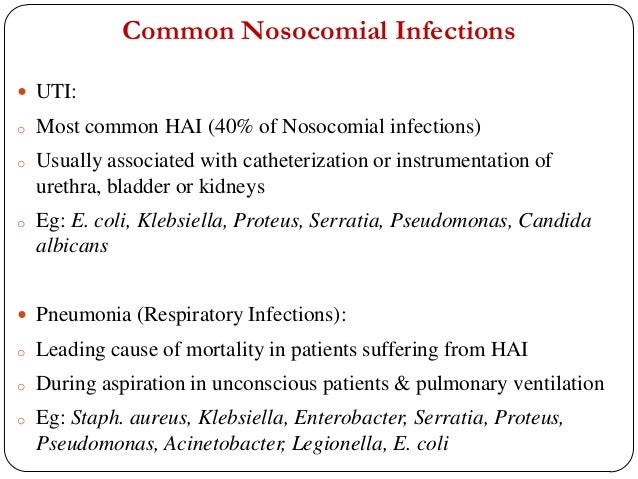HOSPITAL ACQUIRED INFECTION
HOSPITAL ACQUIRED INFECTION(NOSOCOMIAL INFECTION)
Nosocomial infection comes from Greek words “ nosus ” meaning disease and “ komeion ” meaning to take care of Also called as HOSPITAL ACQUIRED INFECTION Infections are considered nosocomial if they first appear 48hrs or more after hospital admission or within 30 days after discharge.
Definition- The term hospital acquired infection or nosocomial (nosocomion, meaning hospital ) is defined as infection developing in patients after admission to the hospital, which was neither present nor in the incubation period at the time of hospitalisation. Such infections may become evident during their stay in the hospital or, sometimes, after their discharge.
Nosocomial or Health care associated infections( HCAI ) appears in a patient under medical care in the hospital or other health care facility which was absent at the time of admission.These infections can occur during health care delivery for other diseases and even after the discharge of the patients.
Types of nosocomial infection
The most frequent types of infection include central line associated blood stream infections,catheter associated urinary tract infections, surgical site infections, and ventilator associated pneumonia.
Factors Influencing nosocomial infection
Risk of infection determining nosocomial infections depends upon the environment (poor
hygienic conditions and inadequate waste disposal from health care setting), the susceptibility and condition of patient( immunosuppression in the patients, prolonged stay in ICU and prolonged use of antibiotics), and unawareness by staff and health care providers( improper) use of injection techniques, poor knowledge of basic infection control measures,inappropriate use of invasive devices and lack of control policies.
Several factors contribute to the occurrence and severity of these infections. These include
1. Susceptible Patients
Many patients in hospitals have impaired defence mechanisms due to pre-exiting diseases,
such as diabetes, immunosuppression and patients with prosthetic implants. So they are more susceptible to infection.
2. Hospital environment
A wide variety of pathogens are present in the hospital environment. Equipment may be
contaminated. Bedding, linen and utensils may act as fomites. Patients shed the organisms
from their bodies while hospital personnel spread these organisms through their hands and clothes.
3. Diagnostic and therapeutic procedures
During diagnostic and therapeutic procedures such as insertion of urethral or intravenous
catheters, the slightest lapse in asepsis may lead to infection.
4. Drug Resistance
Hospital infections are generally refractory to treatment as infecting agents are usually multidrug resistant.
5. Transfusion
Blood, blood products and intravenous fluids, if not properly screened, can transmit many
infections.
6. Advances in Medical Progress
Advances in treatment of cancer, organ transplantation, implanted prostheses and other
sophisticated technologies enhance the risk of infection.

NOSOCOMIAL PATHOGENS –
Pathogens responsible for nosocomial infections are bacterial, viral, fungal.
BACTERIA-
- Bacteroid fragilis is a commensal bacteria found in intestinal tract.
- Clostridium difficle cause inflammation of colon leading to antibiotic associated diarrhoea and colitis.
- S.aureus transmit through direct contact, open wounds and contaminated hands. It causes sepsis, pneumonia and SSI by travelling from organ or blood stream.
VIRUSES-
- HIV and hepatitis B and C viruses are transmitted by contaminated blood and blood products.
FUNGI-
- Candida albicans, Aspergillus, Mucor, Entamoeba histolytica, Pneumocystis carinii and Toxoplasma gondii may also cause infection.
MODES OF TRANSMISSION

1. Contact
It is the principle route of transmission. Staph. aureus and Str. pyogenes are two important
pathogens spread by hand contact.
Instruments like endoscope, bronchoscope, cystoscope (if not properly disinfected) may
transmit pathogenic organisms (e.g. Pseudomanas aeruginosa)
2 Air Borne-
- Droplets- Transmitted by inhalation.
- Dust- Dust may contribute in spread of infections e.g. Pseudomonas aeruginosa, Staph. aureus
- Aerosols- Aerosols transmit certain pathogens to the respiratory tract e.g. Legionella
- pneumophila.
3. Oral route
Hospital food may contain antibiotic resistant bacteria (Pseudomonas aeruginosa, E. coli,
Klebsiella spp. and others) which may colonise intestine and later cause infection in
susceptible patients.
4. Parenteral route
Certain infections may be transmitted by blood transfusion or tissue donation, contaminated blood products and infusion fluids. Hepatitis B and HIV are two viruses which may be transmitted in this way.
COMMON HOSPITAL ACQUIRED INFECTIONS
1. Urinary Tract Infections
UTI is caused by Esch.coli, Klebsiella, proteus, Serratia, Pseudomonas, enterococci and Candida albicans. Infection can be prevented by strict asepsis during catheterisation.
2. Respiratory Infection
Aspiration in unconscious patients and pulmonary ventilation may lead to nosocomial
pneumonia. The pathogens include Staph.aureus, Klebsiella spp., Enterobacter, Serratia,
Protius, Esch.coli, aPseudomonas aeruginosa etc.
3. Wound and Skin Sepsis
Most wound infections manifest within a week of surgery, e.g. Staph.aureus, Pseudomonas
aeruginosa, Esch.coli, Proteus.
4. Gastrointestinal Infections
Salmonella and Shigella sonnei are mainly associated with these infections.
5. Burns
Staph.aureus, Pseudomonas aeruginosa and Str.pyogens are responsible for hospital acquired infections in cases of burns.
6. Bacteraemia and septicaemia
These may be consequences of infection at any site but generally caused by infected intravenous cannulae. Staph.epidermidis bacteraemia is found commonly in patients with artificial heart valves. Bacteraemia in those with valvular defects may lead to endocarditis.
DIAGNOSIS
Diagnosis is by the routine bacteriological methods such as direct smear examination, culture and sensitivity testing. This requires the samples from possible sources of infection such as hospital staff, inanimate objects, water, air, food.
PREVENTION
Nosocomial infection can be prevented by following means

1. Standard precaution- Use of
- proper hand hygiene
- respiratory hygiene
- PPI
- Injection safety
- medication storage and handling
- proper sterilisation and disinfection of inanimate objects
2. Transmission based precautions
- contact precaution
- droplet precaution
- airborne precaution
3. Immunization of carrier staff
4. Proper investigation of HAI and the treatment of such cases.
5. Education and training of health care staff